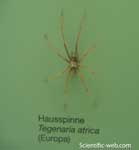Tegenaria atrica is one of the biggest spiders of Central Europe. Females grow up to 18 mm, males up to 15 mm. Adult males can be found from July to October, adult females occur all year. Description The two sexes do not differ in coloration or markings. Its coloration is mainly dark brown. On its sternum is a lighter marking, with three light spots on each side. The opisthosoma features a lighter middle line with six "spots" on each side. In contrast to other species in the genus Tegenaria, T. atrica and the smaller T. picta have uniformly colored legs. In other species, the legs are annulated or spotted. In females, the legs are up to twice the body length, in males even three times. They are able to achieve speeds of up to 50 cm/s for short distances. Its eight eyes are of equal size and are arranged in two rows. As the eyes contain fewer than 400 visual cells, T. atrica can probably only distinguish light and dark. Biology T. atrica often builds its funnel web in undisturbed corners. The web does not contain glue, and if an animal gets entangled in the web, the spider runs towards it, crushes the animal to a pulp, which is then digested. T. atrica normally lives for two or three years, but lifetimes of up to six years have been observed. While the female only leaves its nest to feed, the male can be found wandering about during the mating season from June to October. At least 60 spiderlings emerge from an egg sac. Unusual for spiders, they are subsocial at this stage: they remain together for about a month, but do not cooperate in prey capture. The amount of cannibalism correlates with the amount of available food. T. atrica molts seven or eight times before reaching the immature adult state, and after a final molt reaches maturity.[1] The Tegenaria Atrica fear humans and they are more runners than hunters if a human comes close.
T. atrica is found in Europe up to Central Asia and Northern Africa. In the last few years the spider has been found in several Northern European countries, like Estonia and Latvia. It was introduced to North America[2], where it is now established. Its original habitat consists mostly of caves, or dry forests where it is found under rocks, but is a common spider in people's homes. Footnotes 1. ^ Pourié & Trabalon 1999 References * Pourié, Grégory & Trabalon, Marie (1999): Relationships Among Food and Contact Signals in Experimental Group-Living Young of Tegenaria atrica. Archives of Insect Biochemistry and Physiology 42': 188-197. * Platnick, Norman I. (2008): The world spider catalog, version 8.5. American Museum of Natural History. Further reading * Prouvost, O.; Trabalon, M.; Papke, M. & Schulz, S. (1999): Contact sex signals on web and cuticle of Tegenaria atrica (Araneae, Agelenidae). Arch. Insect Biochem. Physiol. 40: 194-202. |
|


